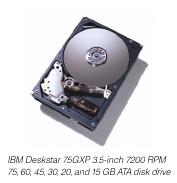The Tom's Hardware Guide Power Box
The Memory Of The Power Box
Intel is bitterly complaining about reviews that are using Athlon-systems with AMD760 chipset and then PC2100 CL2 DDR-memory, beating Pentium 4 platforms in virtually every benchmark. It is correct that right now there isn't any PC2100 DDR-SDRAM with a CAS-latency of only 2 available yet. However, I found out that Micron/Crucial's PC2100 CL 2.5 DDR-SDRAM runs 100% reliable at extremely fast memory timing settings, including a CAS-latency of 2. The Power Box is equipped with two 128 MB DIMMs of the above-mentioned memory, summing up to 256 MB in total. The memory timing settings in the BIOS of MSI's K7 Master S were 8-8-4-2-2-2-2.
The Graphics Card Of The Power Box
This decision was any easy one. As long as NVIDIA's upcoming new 3D-chip with the code name 'NV20' is not available, the fastest 3D-card is clearly equipped with NVIDIA's GeForce 2 Ultra. I was actually using a reference card, but any GeForce 2 Ultra card on the market would do. I also decided against the overclocking of this graphics card, because the system was supposed to be a solid and reliable performer.
The Hard Drive Of The Power Box
In this first Power Box article I thought it would be sensible to use an IDE hard drive. Right now our power box is equipped with IBM's DeskStar 75GXP DTLA-307075. With ATA100-support, a maximum sustained data transfer rate of 37 MB/s, an average seek time of only 8.5 ms and a capacity of 75 GB it is currently the best IDE-drive available. I can already hear the complaints why the Power Box does not come with a SCSI-160 hard drive although its motherboard has got an onboard SCSI-160 adapter. The second edition of the power box will be quipped with a 15,000 RMD SCSI drive and 'NV20', but until then the Deskstar 75GXP will do just fine.
Get Tom's Hardware's best news and in-depth reviews, straight to your inbox.
Current page: The Memory Of The Power Box
Prev Page The Motherboard Of The Power Box Next Page Other Components
